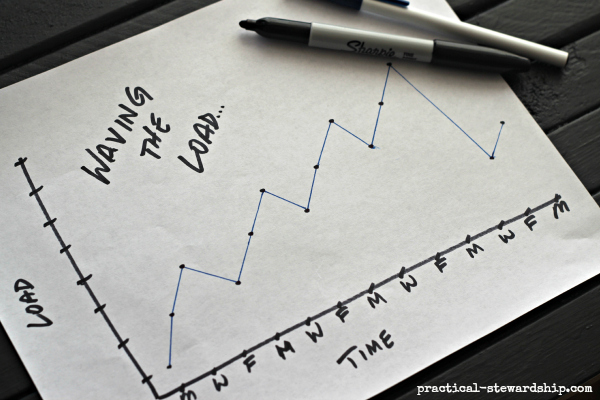Are you struggling to make fitness progress? Have you hit a plateau in your training and don’t know how to bust out of it? If so, you’re not alone…and there’s good news.
The Problem of Plateaus
For most of us, plateaus come when we don’t vary the work load in our exercise regimen. There are a number of ways to explain this, but perhaps I’ll start with an example.
 Imagine that your run three miles three times per week (say, Monday, Wednesday and Friday). Is it realistic to expect that you will shave 10-30 seconds off of your time every time you go for a run? If you record a time of 27:05 on Monday, is it realist to assume that by the following Monday, of course you’ll be in the low 26-minute range? Maybe…at first. But is this sustainable? Of course not.
Imagine that your run three miles three times per week (say, Monday, Wednesday and Friday). Is it realistic to expect that you will shave 10-30 seconds off of your time every time you go for a run? If you record a time of 27:05 on Monday, is it realist to assume that by the following Monday, of course you’ll be in the low 26-minute range? Maybe…at first. But is this sustainable? Of course not.
Don’t believe me? Just run with the example. Let’s say you shave 15 seconds off of your time each time you go out. At that rate, in a mere 35 weeks of training you’d be running your three miles in 15 seconds, or 720 miles per hour. Somewhere it has to break down, right?
And from a fat-burning angle, God has made the human body to be very adaptive and efficient. That means that as you run your three miles, you are going to get more efficient at doing so. Your heart will get stronger and you will expend less and less energy as you improve…even if your times don’t steadily decrease. (Yet another reason why steady state cardio is not the best method for fat loss. As your body adapts, you have to keep running farther and longer to burn the same number of calories as when you started out.)
So how do you keep making gains? By waving the load.
Waving the Load
“Waving the load?”
Yup.
 This means that you vary the work, whether the actual weights, the intensity, or the rest so as to give your body a break and help it to keep adapting.
This means that you vary the work, whether the actual weights, the intensity, or the rest so as to give your body a break and help it to keep adapting.
For instance, several weeks ago I posted a kettlebell swing-based program, and you may notice that it includes a light, medium and heavy day. All I prescribed in it was a variation of the number of sets of work. It looked like this:
- Five rounds of swings on Monday (Heavy Day)
- Three rounds of swings on Wednesday (Light Day)
- Four rounds of swings on Friday (Medium Day)
Make sense?
Too many folks try to go at 100% every workout, only to find themselves going backward. That’s not sustainable. You burn out mentally and don’t give your body time to adapt or sufficiently recover.
Any good program is going to involve a variety of intensity and load, even if the movements are relatively consistent (though I tend to like enough variety to keep it interesting, so long as I’m working toward my specific goals).
A Real-Life Scenario
I’ll finish with a snapshot of what I’m doing right now, to give you yet another example of what this looks like.
Right now (and for the next several weeks) my schedule looks like this, with a bit of flexibility built in:
Monday: Strength Tuesday: Conditioning Wednesday: off Thursday: Strength Friday: Conditioning Saturday & Sunday: off
For the strength component, I warm up with some bodyweight movements (e.g., pull-ups, hanging leg raises, handstand pushups, squats, bridges, etc). Then I chase that with the meat and potatoes of this current program: the Double Kettlebell Front Squat.
For the conditioning, it’s still strength based as I’m doing few, heavy, explosive reps of swings, snatches and cleans. (I’m also occasionally doing a bit of running with Sonja for fun. I can’t believe I just wrote “running” and “fun” in the same sentence….)
As for the waving of the load on the Front Squats, last week I did this:
Monday
Double Kettlebell Front Squat (70#) Ladders.
I did a density workout, setting the timer for 15:00, then doing as many “ladders” of as possible in the time allowed. (I did “ladders” of three “rungs,” meaning I would do 1, then 2, then 3 reps, then rest.) I completed 5 ladders in 15:00, which worked out to 30 reps. I was tired, but not exhausted. Felt pretty good, overall.
Thursday
With the same weight as Monday, I did this:
10-minute countdown (i.e., when the second hand hit zeros, I did…): Double Kettlebell Front Squat (70#) – 3 reps.
So in 10 minutes, I did the same number of reps as I did in 15 minutes on Monday.

This week I did this:
Monday
8 rounds, 90 seconds each: Double Kettlebell Front Squat (70#) – 4 reps
Thursday
6 rounds, 90 seconds each: Double Kettlebell Front Squat (70#) – 4 reps
So that’s sort of what it looks like. And little by little, without destroying my body or getting crazy, my numbers just keep creeping up as I’m getting stronger. You can do this too.
So what about you? Have you hit a plateau and stalled in your progress? How can you apply these principles in your own training?
I love this idea of waving the load! Not only is it good to keep the body guessing, but the workouts don’t get boring, as you have something new to do each day. Thanks so much for this tip! I get very stuck in a rut in my workouts (when I actually do workout!)
Yes, waving the load is a way to enjoy variety while also being able to work toward a specific goal. It’s not variety for variety’s sake, but rather strategic variety. I can make progress on a goal to press half my body weight while strategically varying the loads of my presses…but still keep pressing. Thanks, Heather!